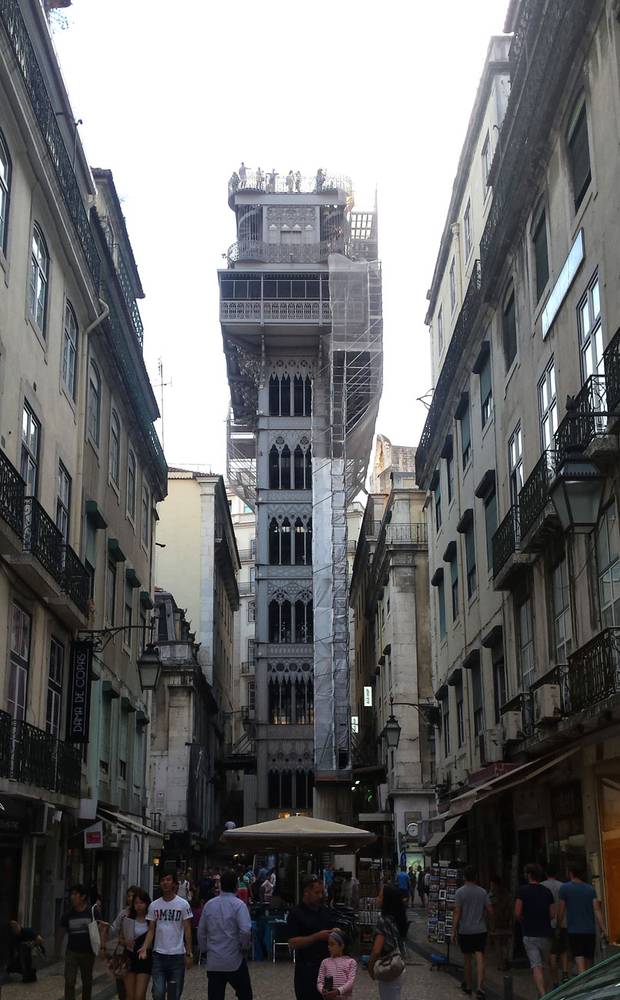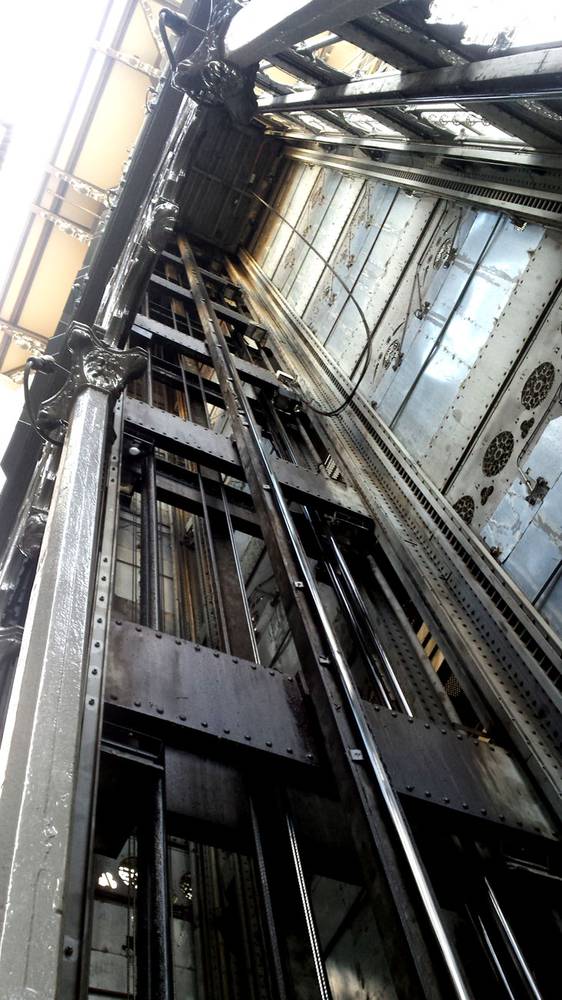The Lift: Past, Present And Future
November 2015
During a recent city break to Lisbon I rode the Santa Justa Elevator, an urban lift which connects the lower central shopping streets of Baixa to the Carmo convent and square which are built on higher ground in the steep, hilly city. Built in a neo-gothic style like a cast iron bell tower, it soars above the surrounding cityscape. The ornately decorated lift shaft with its lancet windows and filigree balustrades emulates the aesthetic of churches which are centuries older, but at its opening in 1902, it was an exemplar of pioneering building technology, and again when it converted its hoisting mechanisms from steam power to electricity two years later.
From the twelfth to the fifteenth-centuries, the gothic church used vaulted ceilings, flying buttresses, stained glass windows and heaven-reaching spires to impress a sense of power on the people attending worship. These innovative building technologies appeared to perform gravity-defying miracles and inspired awe with their ‘magical’ alternatives to the building norms of the era.
Peering into the internal mechanisms of the Santa Justa Elevator it struck me that, essentially, lift technology has remained much the same ever since 1902. The hoisting cables and counterweights looked much like any modern day lift shaft. The operational design of today’s vertical lift has not altered greatly since 1852 when the American Elishna Otis is credited for inventing the ‘safety elevator’; a cable-operated system which included a failsafe to prevent the lift car from falling if a hoisting cable broke.
ISSUES OF CURRENT LIFT DESIGN
Vertical lift shafts are spatially inefficient. Whilst essential for the delivery of tall buildings, they can be said tostealfloor space at the same time as they enable access to them. The space the lift shafts occupy (as much as 40% of a floor plan) is used for vertical movement only and currently, no matter the height of the building, conventional lift shafts can only accommodate a single lift car. For every moment that the lift is not at a particular floor, the shaft is essentially unused and wasted void space.
Double-decker lifts improve this efficiency by serving two floors simultaneously, each level of the car taking people to odd or even numbered storeys. Research and innovations in lift technology have mainly focused on increasing the speed at which the cars can travel, reducing both waiting and travel time and therefore efficiency of people flow. Others have focused on lightening the weight of the cables used to hoist the cars, thus increasing the maximum height shafts can be built at.
THE ONLY WAY IS UP (OR DOWN)
Recently, more radical proposals have attempted to rethink the principles of lift technology. The biggest challenge to the industry is to find a way of getting past the one-car-per-shaft limitation. In an attempt to solve this, an older technology was revisited and adapted; the Paternoster.
Paternoster lifts differ in that they are a constantly moving chain of doorless boxes moving up in one shaft and down in another. These boxes move at slower speeds than conventional lifts to allow passengers to hop on or off at the desired floor but, conversely, waiting time is never an issue. Safety, however was the major setback of this system with passengers exposed to moving surfaces and ultimately meant that the concept was virtually abandoned. Whilst the UK has less than a handful still in operation (the most famous is perhaps at the University of Sheffield’s Arts Tower), there are more than 250 working examples in Germany.
Hitachi’s ‘Circulating Multi Car Elevator System’ is a development of the Paternoster type which allows multiple cars to operate in a single shaft. One lift car can come to a halt at floors allowing passengers on and off safely whilst a car behind can continue its ascent/descent. This system utilises the familiar (and safe) doors which open and close whilst the car is stationary at a lift lobby.
Multiple cable systems allow for the cars to move independently from one another with cars traveling up in one shaft and down in the other. The positions of the cars are managed and safe distances are maintained by computer. Hitachi built a one-tenth-scale model to prove the workings of the system but a full size prototype is still as yet to be constructed. The manufacturer claims that the efficiency of this system is twice that of conventional lifts.
TOWERING AMBITION
Another revolutionary system which models itself on Paternoster principles is further challenging the concepts of lift technology. For the first time, a cable-free or ‘ropeless’ solution is proposed: Thyssen Krupp’s MULTI system.
This new lift concept sees the cars move sideways as well as up and down, turning a historically one-dimensional circulation system into a two or even three-dimensional one. The drive system uses linear induction motors mounted to the cars themselves and completely replaces the hoisting cables with tracks. The self-propelled cars use one set of motors for horizontal movements and another set for vertical. Travelling at 5 metres a second (around half the speed of the fastest conventional lifts) waiting time is greatly reduced as a stream of lift cars would be able to serve a floor every 15-30 seconds. With a constant ‘train’ of cars able to take you to any point in the building, this lift of the future operates more like a metro system.
The workings of the MULTI system have been demonstrated recently through a one-third scale model. A full-sized prototype of this system is expected to be completed by the end of 2016.
With lifts no longer limited to vertical shafts and with a continuous flow of lift cars, this technology could alter the shape, size and the way in which we move around large buildings in the future. The proposed system greatly improves efficiency and takes up less space giving precious and valuable floorspace back to other uses. Offering 3-dimensional movement, it could also serve and connect a number of buildings.
FURTHER WATCHING
MULTI first rope-free elevator system by ThyssenKrupp
Circulating Multi-Car Elevator System "Exponential increase in carrying capacity" – Hitachi


